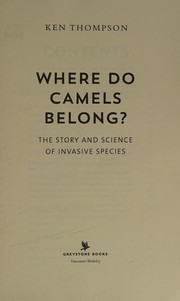Check nearby libraries
Buy this book

Where do camels belong? In the Arab world may seem the obvious answer, but they are relative newcomers there. They evolved in North America, retain their greatest diversity in South America, and the only remaining wild dromedaries are in Australia. This instructive and controversial book delivers unexpected answers.
Check nearby libraries
Buy this book

Previews available in: English
| Edition | Availability |
|---|---|
|
1
Where do camels belong?: the story and science of invasive species
2014, Greystone Books
in English
1771640960 9781771640961
|
aaaa
|
|
2
Where do camels belong?: the story and science of invasive species
2014, Profile Books
in English
1781251746 9781781251744
|
zzzz
|
Book Details
Table of Contents
Where do camels belong?
Species on the move. Species and continents ; Relicts, refugia, and ice ages ; Migrations, ocean dispersal, and islands ; Dispersal by humans ; What a long, strange trip it's been
A short history of nativeness. What is native? ; War and peace ; The value of nativeness ; The conservation imperative ; Follow the money ; The rest of this book
First some bad news, Brown tree snake ; Zebra mussel ; Tamarisk ; Purple loosestrife
Guilty as charged? Purple loosestrife ; Tamarisk ; Zebra mussel ; OK, but what about the brown tree snake?
If it's nice, it must be native. The native British flora ; Hares, rabbit, and crayfish ; Beavers in Britain ; The misunderstood dingo ; Caribbean raccoons ; The tangled tale of the pool frog ; Nativeness under attack
A short course in ecology. Some niche theories ; Testing niche theory ; Niches and invasions ; Aliens and global biodiversity ; Lessons from history
Spotting the bad guys. Winners and losers ; Two rather unsuccessful theories ; A slightly better theory ; Acclimatisation societies
Out of control. Aliens and islands ; A mainland example : the devil's claw ; Useful aliens ; Biological control and a tale of two snails ; Aliens and the law
No going back. Making the best of aliens ; A longer perspective ; Alien evolution ; Evolution of the invaded ; The tip of the iceberg
Levelling the playing field. Deliberate introductions : the strange tale of the harlequin ladybird ; Gardeners' world ; Japanese knotweed : lice to the rescue
Five myths about invasions. #1, Alien invasions reduce biodiversity and ecosystem function ; #2, Alien species cost us a fortune ; #3, Aliens are always to blame ; #4, Aliens are out to get us ; #5, Aliens are bad, natives good.
Where do we go from here?
Edition Notes
Originally published: London : Profile Books, 2014.
Includes bibliographical references (pages 227-242) and index.
Classifications
The Physical Object
Edition Identifiers
Work Identifiers
Community Reviews (0)
| April 17, 2024 | Edited by ImportBot | import existing book |
| October 25, 2023 | Edited by Scott365Bot | import existing book |
| July 18, 2019 | Created by MARC Bot | import new book |









